How To Avoid Pinching Inner Tube Motorcycle? Explained
In this article, we’ll explain How To Avoid Pinching Inner Tube Motorcycle? Avoiding pinching your motorcycle’s inner tube is essential for a smooth and safe ride. This common issue can lead to unexpected flats and can be avoided with proper technique and preparation. By understanding the causes and implementing the right strategies, riders can ensure their inner tube remains intact. This guide will provide detailed instructions to help motorcycle enthusiasts maintain their tires and enjoy uninterrupted rides.
Key Takeaways
- Always inspect the rim and tire for sharp edges before installation.
- Use the correct tire levers and technique to avoid applying excessive force.
- Inflate the inner tube slightly before fitting to avoid trapping it between the tire and rim.
- Ensure the tire bead sits correctly around the rim before fully inflating.
- Regularly check and maintain tire pressure to prevent under-inflation-related pinch flats.
How To Avoid Pinching Inner Tube Motorcycle?
To avoid pinching the inner tube of a motorcycle, ensure the tire and rim are clean and free from debris, slightly inflate the inner tube before installation, carefully insert the tube and tire onto the rim without using excessive force, and check that the tube is not trapped under the tire bead before fully inflating.
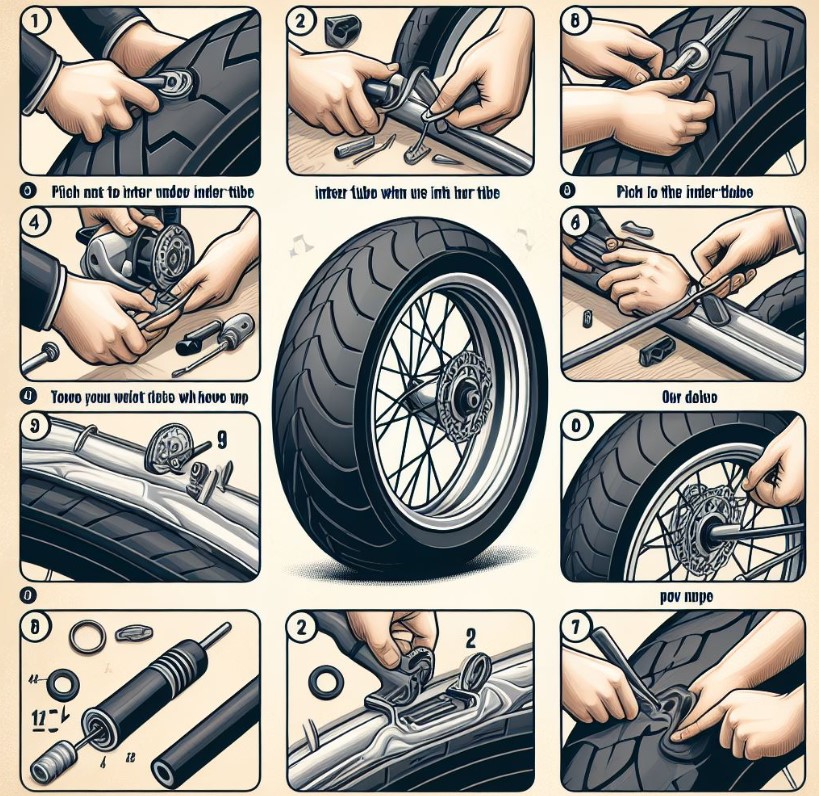
Proper Preparation
Before diving into the tire-changing process, it’s essential to prepare adequately. Begin by gathering all necessary tools and materials. A clean workspace and the right tools can make a significant difference in preventing the pinching of the inner tube motorcycle. Ensure you have quality tire levers, a pump, and a new inner tube if needed.
Assessing Your Materials and Workspace
Start with assessing your workspace and materials. A clean, flat surface will reduce the risk of dirt or debris causing tube damage. Check your tire levers for any sharp edges or burrs that could puncture the tube. Having the correct tools and environment is the first step to a successful tire change without damaging the inner tube.
Preparing the Inner Tube and Tire
It’s vital to slightly inflate the inner tube before installation. This minor inflation helps it keep its shape and reduces the chances of it getting pinched. Also, inspect the tire and rim for any sharp objects or irregularities that could harm the tube.
Correct Tire Removal and Installation
The technique used to remove and install the tire can significantly affect the risk of pinching the inner tube. A methodical approach reduces the chances of mistakes and damage.
Tire Removal Techniques
When removing the tire, start by fully deflating the inner tube to avoid any resistance. Use the tire levers correctly, inserting them at the opposite side of the valve to prevent damage. Lever the tire off gently, avoiding any forceful tugging or pulling that could stretch or tear the inner tube.
Tire Installation Tips
During installation, begin near the valve and work your way around. Make sure the inner tube is not twisted and that it sits evenly inside the tire. Carefully lever the tire back onto the rim, ensuring not to pinch the inner tube between the tire and the rim.
Importance of Tire Pressure
Maintaining the correct tire pressure is not only vital for your motorcycle’s handling and fuel efficiency but also for preventing inner tube damage. Incorrect tire pressure, especially under-inflation, can lead to ‘pinch flats.’
Understanding Tire Pressure
The right tire pressure will vary depending on your motorcycle model and the type of riding you do. Consult your motorcycle’s manual or a trusted resource to find the optimal pressure for your situation.
Checking and Adjusting Pressure Regularly
Regular checks and adjustments to your tire pressure can prevent many common issues, including pinched inner tubes. Make it a habit to check your tire pressure frequently, especially before long rides or carrying additional weight.
Leveraging the Right Tools and Techniques
The tools and techniques you use can make a significant difference in preventing damage to the inner tube. Using the correct tools and following the best practices can protect your motorcycle’s inner tube from unnecessary harm.
Choosing the Right Tire Levers
Not all tire levers are created equal. Opt for high-quality, motorcycle-specific tire levers that are less likely to cause damage. Avoid using screwdrivers or other sharp tools that could puncture the inner tube.
Mastering Tire Changing Techniques
Developing skill and patience in changing tires can prevent many common mistakes. Take your time, and if you feel resistance, stop and reassess rather than forcing the tire into place.
Regular Maintenance and Inspection
Regularly inspecting and maintaining your motorcycle’s tires and inner tubes can prevent many issues, including pinching. This proactive approach ensures your rides are safe and enjoyable.
Routine Tire Inspection
Check your tires and inner tubes regularly for signs of wear, damage, or foreign objects. Catching problems early can prevent more severe issues down the line.
Scheduled Maintenance
Incorporate tire and inner tube checks into your regular motorcycle maintenance routine. This includes checking tire pressure, tread depth, and any signs of aging or damage to the inner tube.
How Do I Stop My Inner Tube From Pinching?
Preventing your inner tube from pinching is crucial for maintaining the longevity and safety of your motorcycle tires. To stop your inner tube from pinching, begin by ensuring that both the rim and tire are free from debris and sharp edges.
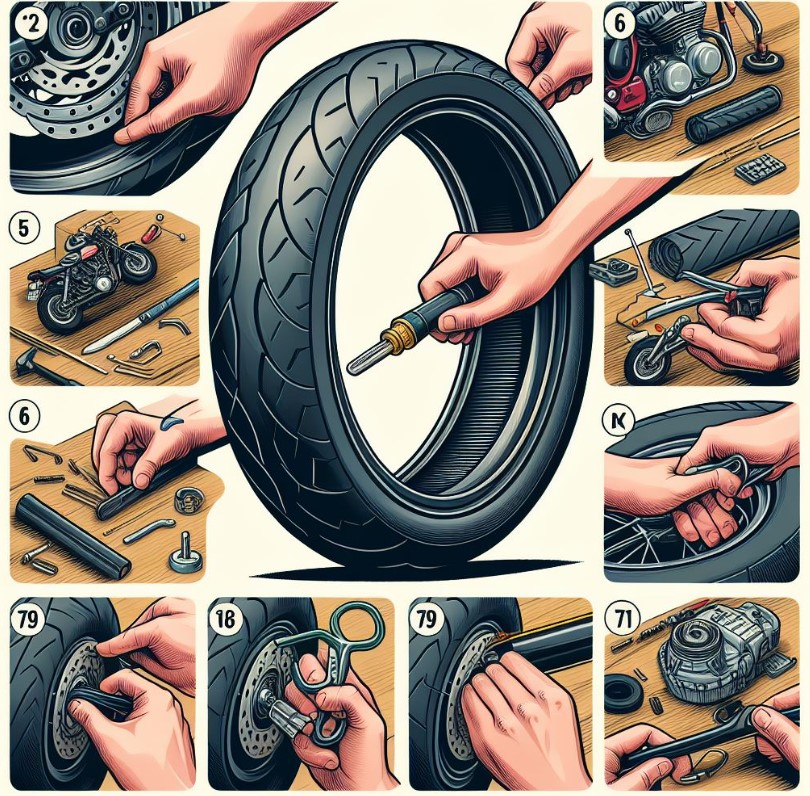
Inflate the inner tube slightly before inserting it into the tire; this helps it maintain shape and avoid getting trapped under the tire bead. When installing the tire onto the rim, do so gently and methodically, starting opposite the valve and working your way around, making sure not to force the tire bead into the rim space.
Use proper tire levers designed for motorcycles to minimize the risk of pinching. Finally, check that the inner tube is not pinched between the tire and the rim by inflating the tire slightly and adjusting as necessary before full inflation.
How Do You Prevent A Pinched Tube?
Preventing a pinched tube involves several key steps during the tire installation process. Firstly, inspect the rim strip to ensure it covers all spoke ends and the rim’s sharp edges, which could puncture the tube.
Lightly inflate the inner tube to give it form, which helps prevent twisting or folding during installation. When mounting the tire, place one bead onto the rim first, then insert the slightly inflated tube.
Carefully work the second bead onto the rim, starting at the valve area and moving towards the opposite side, using your hands as much as possible to avoid tool intervention. If tools are needed, use only plastic tire levers and insert them carefully to avoid catching the tube between the lever and the rim.
How Do You Install A Bike Tube Without Pinching It?
Installing a bike tube without pinching it requires attention to detail and patience. Start by removing the old tube and checking the inside of the tire and the rim for any sharp objects or irregularities.
Slightly inflate the new tube to give it shape, which makes it easier to handle and less likely to fold over or twist. Insert the valve through the valve hole in the rim and gently tuck the tube into the tire all around.
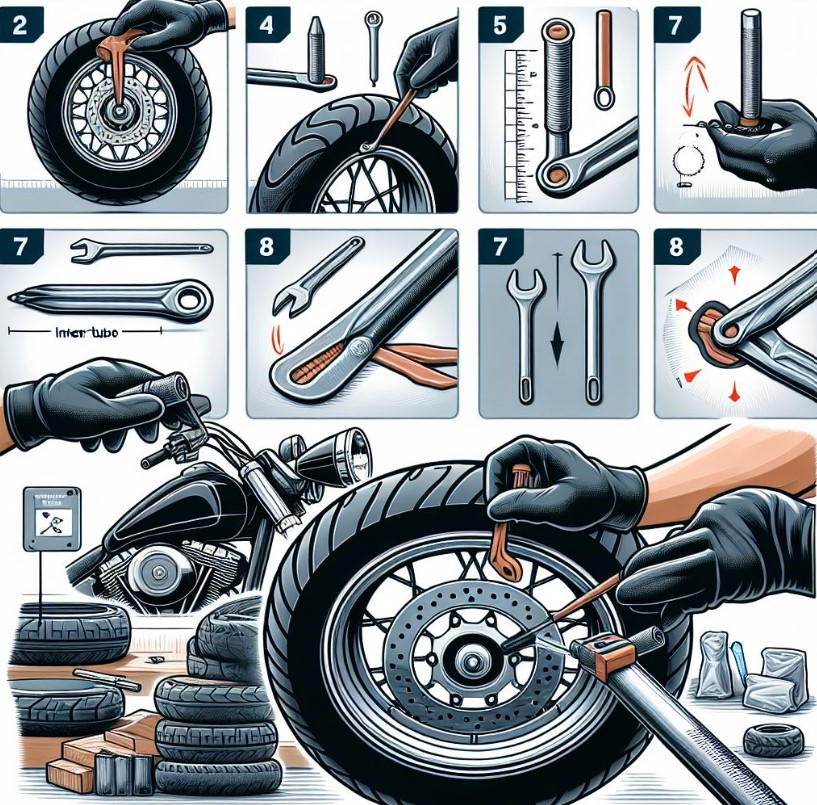
Carefully place the first bead of the tire onto the rim, followed by the second bead, ensuring that you do not trap the tube underneath.
Begin at the valve and finish opposite it, pushing the valve up into the tire to ensure the tube is not caught under the bead. Inflate the tire slowly, checking to ensure that the bead is seating correctly and the tube is not being pinched.
How Do You Not Get A Pinch Flat?
Avoiding a pinch flat, also known as a ‘snakebite’, involves maintaining proper tire pressure, handling the inner tube carefully during installation, and riding cautiously.
Always maintain your tires at the recommended pressure level, as under-inflated tires are more prone to pinch flats, especially when riding over potholes, edges, or rough terrain.
Check your tire pressure regularly with a reliable gauge. When installing the tube, ensure it is not twisted and is slightly inflated to avoid being caught under the tire bead.
Finally, adapt your riding style: avoid harsh impacts and try to ride around obstacles rather than over them. For off-road riding, consider using thicker tubes or tubeless setups to further reduce the risk of pinch flats.
Conclusion
Preventing inner tube pinching is crucial for maintaining your motorcycle’s performance and safety. By following the correct preparation, installation techniques, and regular maintenance, riders can avoid the common pitfalls that lead to pinched tubes.
Remember to inspect your equipment, use the appropriate tools, and maintain proper tire pressure. With these practices, you can extend the life of your motorcycle tires and enjoy a safer, more reliable ride.
Top FAQ’s
What should I do if I keep experiencing pinched inner tubes despite taking precautions?
If you continually face this issue, review your tire changing technique to ensure it’s correct and gentle. Also, inspect the rim for any damage or sharp edges that could be causing the problem. If the issue persists, consult a professional mechanic to check for underlying issues with your wheel or tire.
Are there any specific types of tires or inner tubes that are less prone to pinching?
Heavy-duty or thicker inner tubes are less prone to pinching compared to standard ones. Some riders prefer tubeless tires, which eliminate the risk of inner tube pinching entirely. However, whether you can use tubeless tires depends on your motorcycle’s wheel type.
Can riding style influence the likelihood of pinching the inner tube?
Yes, aggressive riding, such as hitting potholes, curbs, or off-road obstacles, can increase the risk of pinching the inner tube. Ride smoothly and try to avoid harsh impacts. For off-road riding, consider using heavier-duty tubes and appropriate tire pressures.
How often should I check my motorcycle’s tire pressure to prevent pinch flats?
Check your motorcycle’s tire pressure at least once a week and before long rides. Correct tire pressure is crucial for preventing pinch flats, improving handling, and extending tire life. Always refer to your motorcycle’s manual for the recommended tire pressure.

Welcome to the exhilarating world of Matt Rex, a professional car racer turned renowned vehicle enthusiast. Immerse yourself in his captivating blog as he shares heart-pounding adventures, expert reviews, and valuable insights on cars, trucks, jets, and more. Fuel your passion for speed and discover the beauty of vehicles through Matt’s engaging stories and meticulous expertise. Join the ever-growing community of enthusiasts who find inspiration and expert advice in Matt Rex’s blog—a digital hub where the thrill of speed meets the pursuit of knowledge.


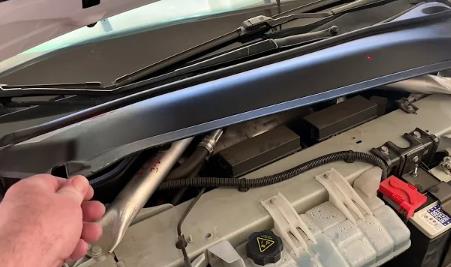

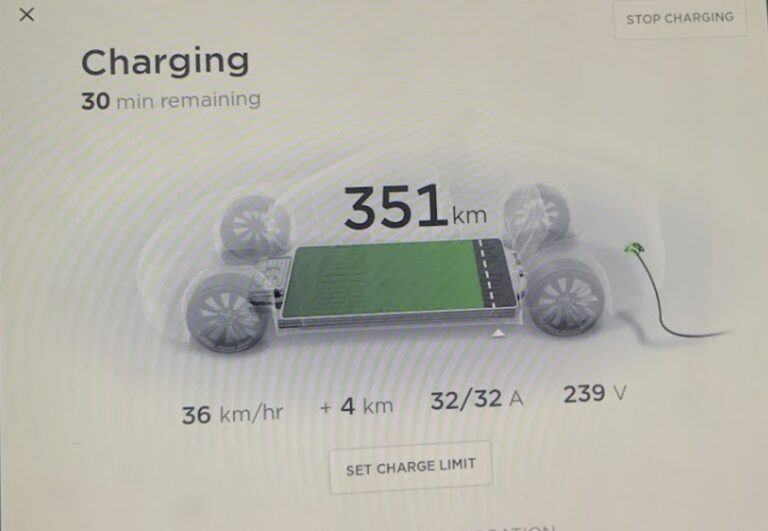


![Subaru Ascent Trunk Not Opening [Causes + Solution]](https://www.turbochaos.com/wp-content/uploads/2023/07/Subaru-Ascent-Trunk-Not-Opening-768x512.jpg)